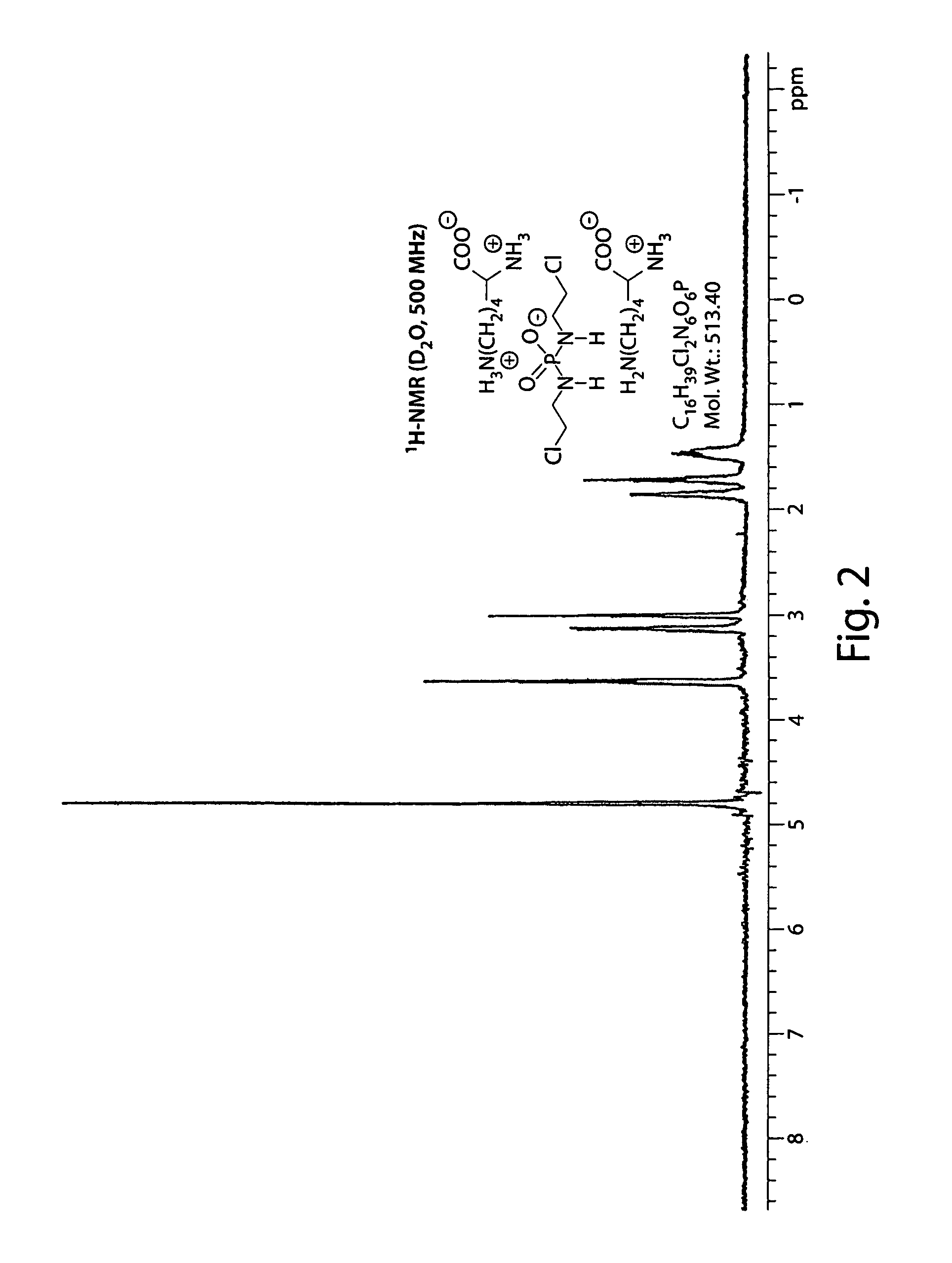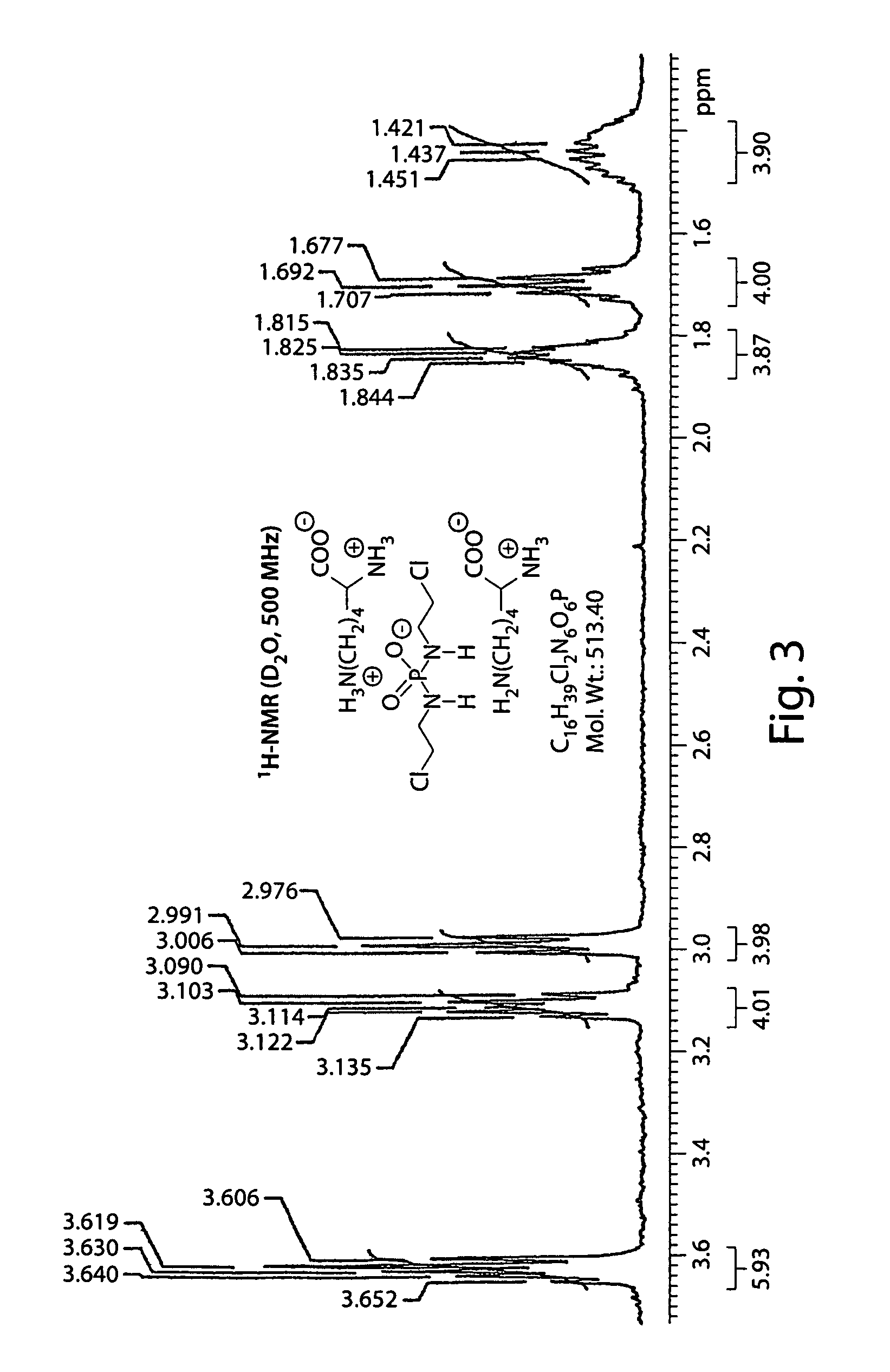Salts of isophosphoramide mustard and analogs thereof as anti-tumor agents
a technology of isophosphoramide and mustard, which is applied in the directions of phosphorous compound active ingredients, drug compositions, biocides, etc., can solve the problems of limited research, low clinical efficacy, and insufficient therapeutic superiority of mechlorethamine, and few of these compounds have demonstrated sufficient therapeutic superiority to mechlorethamin
- Summary
- Abstract
- Description
- Claims
- Application Information
AI Technical Summary
Benefits of technology
Problems solved by technology
Method used
Image
Examples
example 1
[0084]This example describes the synthesis of the phenyl ester of IPM according to the scheme.
[0085]
To a 5 L 3 neck round bottom flask equipped with a mechanical stirrer, a 500 mL drip funnel and a calcium chloride drying tube 2-chloroethylamine hydrochloride (116 g; 1.0 mol) is suspended in 1200 mL methylene chloride and stirred in an ice water bath. When the temperature fell to 5° C., phenyldichlorophosphonate (105.5 g; 0.5 mol) (commercially available from Aldrich, Milwaukee, Wis.) was added. Triethylamine (202 g, 2 mol) was dripped in slowly at 1 drop per second; the temperature did not exceed 5° C. The mixture is allowed to stir overnight. The following day, 200 mL concentrated hydrochloric acid (12 M) was mixed with 1800 mL water. To the reaction mixture was slowly added 200 mL of the acid solution. The mixture became clear and was transferred to a 2 L separatory funnel and the organic and aqueous layers separated. The organic layer was extracted with the acid solution 9×200 m...
example 2
[0086]This example describes the synthesis of IPM (N,N′-di(2-chloroethyl)phosphorodiamidic acid) from the IPM phenyl ester described in example 1.
[0087]
The white solid ester from example 1 (0.39 mol) was dissolved in 100 mL of 95% ethanol and added to a Parr flask and 2.5 g PtO2 was added. The suspension was hydrogenated at 50 PSI; two hours later the hydrogenation was stopped and 2.5 g PtO2 was cautiously added with stirring. Hydrogenation was resumed at 50 PSI for two hours. It was then stopped, brought to ambient pressure and heated on a hot plate with magnetic stirring. When the suspension was boiling it was suction filtered immediately through a 5.5 cm suction funnel with two filter papers and the supernatant stored at 5° C. for two hours; the catalyst is saved and added to the Parr flask and stored in a freezer overnight. The white solid that formed was suction filtered through a 9 cm suction funnel and saved in a pesticide free jar; the mother liquor was added to the Parr fla...
example 3
[0088]This example describes the preparation of IPM lysine salt from IPM produced according to example 2. The L-lysine was weighed (26.4 g) and the water measured (6 L). The L-lysine is added to the water with stirring @ 2-8° C. The bulk drug substance, IPM, is weighed (20 g) and added slowly with stirring @ 2-8° C. to the lysine solution.
[0089]Once dissolved at 2-8° C., the solution is passed through a sterile antimicrobial filter (0.22 microns). The solution is maintained at 2-8° C. and dispersed into vials under sterile conditions.
[0090]The dissolved product is then lyophilized under the following conditions.
[0091]
TimeTemperature(Hours)Action(° C.)0-1Loading0-45 1-7Hold−45 7-34Primary Dry−2534-55Secondary Dry−1055-76Secondary Dry076+Nitrogen purge0
Alternatively, the dissolved product may be lyophilized under the following conditions.
[0092]
TimeTemperature(Hours)Action(° C.) 0-0.5Loading0-45 0.5-6.5Hold−456.5-33 Primary Dry−2533-54Primary Dry−1054-95Secondary Dry095+Nitrogen purge...
PUM
 Login to View More
Login to View More Abstract
Description
Claims
Application Information
 Login to View More
Login to View More - R&D
- Intellectual Property
- Life Sciences
- Materials
- Tech Scout
- Unparalleled Data Quality
- Higher Quality Content
- 60% Fewer Hallucinations
Browse by: Latest US Patents, China's latest patents, Technical Efficacy Thesaurus, Application Domain, Technology Topic, Popular Technical Reports.
© 2025 PatSnap. All rights reserved.Legal|Privacy policy|Modern Slavery Act Transparency Statement|Sitemap|About US| Contact US: help@patsnap.com



